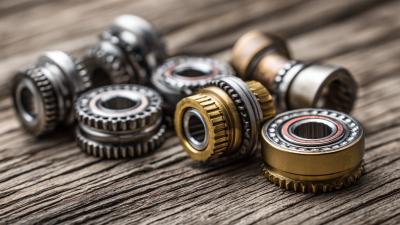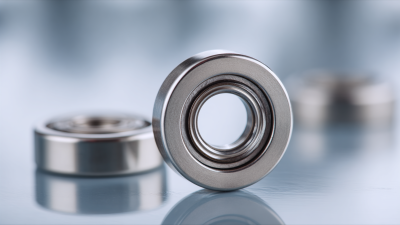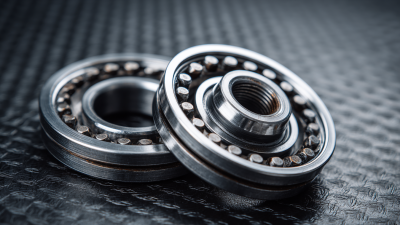How to Choose the Right Stainless Steel Needle Bearings for Your Application
Table of Contents
- Understanding the Different Types of Stainless Steel Needle Bearings Available
- Key Factors to Consider When Selecting Needle Bearings for Specific Applications
- The Importance of Load Capacity and Speed Ratings in Needle Bearing Selection
- Maintenance Tips for Extending the Life of Stainless Steel Needle Bearings
- Common Mistakes to Avoid When Choosing Needle Bearings for Your Project
- FAQS
- Conclusion
- Related Posts
You know, in the world of industrial machinery that’s constantly changing, picking the right components is super important if you want your equipment to run smoothly and last longer. Stainless Steel Needle Bearings, for example, are becoming a pretty big deal these days. They’re known for handling heavy loads and resisting corrosion — basically, they get the job done no matter what. I recently read in this industry report from MarketsandMarkets that the worldwide bearings market is expected to hit around $65 billion by 2027. A big chunk of that growth comes from the increasing need for high-performance bearings in industries like automotive, mining, and agriculture. Here at Shandong Hangshuo Bearing Co., Ltd., we’ve been around since 2015. We focus on researching, developing, manufacturing, and selling all kinds of bearings — especially those built for tough, demanding situations. So, if you’re wondering how to pick the right Stainless Steel Needle Bearings, knowing your options can really help keep your operations efficient and dependable over time.

Understanding the Different Types of Stainless Steel Needle Bearings Available
When you're picking out stainless steel needle bearings for your specific needs, it’s really important to get a good grasp of the different types out there. That way, you can make sure you’re choosing something that’s gonna perform well and last long. These bearings are pretty popular because they handle heavy loads without taking up too much space — making them perfect for everything from cars to heavy machinery. That’s a big part of what Shandong Hangshuo Bearing Co., Ltd. is all about. We started back in 2015, and since then, we’ve focused on providing top-quality bearings for all sorts of industries—mining, engineering, textiles—you name it.

There are actually quite a few types of stainless steel needle bearings, each designed to suit different kinds of jobs. For example, standard needle bearings work great when you need low friction and the ability to spin super fast, while thrust needle bearings are better suited for handling loads along the axis. Industry reports show that demand for these bearings is expected to grow by around 4.5% every year. That’s mainly because manufacturing techniques keep improving, and everyone’s really focused on making things more efficient.
A quick tip: when you’re choosing needle bearings, don’t forget to think about how much weight they'll need to handle, how fast they’ll be spinning, and the environment they’ll be working in. Also, making sure they’re well-lubricated can really extend their lifespan and boost performance. And don’t overlook regular checkups—staying on top of maintenance can prevent small issues from turning into costly failures down the line.
Key Factors to Consider When Selecting Needle Bearings for Specific Applications
So, when you're trying to pick the right stainless steel needle bearings for your project, there are actually a few important things to keep in mind. For starters, the global bearings market is pretty huge—valued at about USD 46.82 billion in 2024—and it’s expected to nearly double by 2032, reaching around USD 97.10 billion. That kind of growth really shows just how much demand there’s been for specialized parts like needle bearings across all sorts of industries—think automotive, aerospace, manufacturing, you name it.
One of the key factors you shouldn’t overlook is the load capacity. These bearings are great at handling radial loads, which makes them perfect if you need to support a lot of weight in a compact space. Also, the material matters a lot—stainless steel is a solid choice because it resists corrosion and holds up longer under tough conditions. And let’s not forget about energy efficiency. More and more, industries are focusing on sustainable practices, and choosing energy-efficient designs can really make a difference by reducing friction and boosting overall system performance.
Getting a good handle on these points will help you make smarter decisions and keep your operations running smoothly. It’s all about understanding what’s really gonna work best for your specific needs.
How to Choose the Right Stainless Steel Needle Bearings for Your Application - Key Factors to Consider When Selecting Needle Bearings for Specific Applications
| Factor | Description | Application Example |
|---|---|---|
| Load Capacity | Consider the maximum load the bearing must support. | Heavy machinery, automotive applications. |
| Speed Rating | Select bearings that can sustain the required rotational speed. | Electric motors, turbine applications. |
| Material Quality | Ensure the stainless steel grade is suitable for corrosion resistance. | Food processing equipment, marine applications. |
| Dimensions | Verify that the bearing dimensions fit the application constraints. | Robotics, automation systems. |
| Operating Temperature | Select bearings that can operate efficiently within the temperature range. | Aerospace applications, high-performance engines. |
The Importance of Load Capacity and Speed Ratings in Needle Bearing Selection
When you're choosing stainless steel needle bearings for your project, it’s pretty important to get a good grip on their load capacity and speed ratings. Basically, load capacity tells you the max weight the bearing can handle without giving out. If you pick a bearing that’s not up to the job, it can wear out early or cause your system to break down sooner than you’d like. For anything heavy-duty, you really want to go with bearings designed to handle higher loads—that way, they last longer and work more reliably.
On the flip side, speed ratings are all about how fast the bearing can spin smoothly. Using one that isn’t rated for your speed can lead to overheating, more friction, or even failure. So, it’s worth taking a close look at how your equipment will be used—think about rotation speeds and how often it’ll be running—and pick a bearing that's up to the challenge. When you balance both load and speed, everything tends to run much more smoothly, and your operation stays efficient without surprises.
How to Choose the Right Stainless Steel Needle Bearings for Your Application
Maintenance Tips for Extending the Life of Stainless Steel Needle Bearings
Taking good care of stainless steel needle bearings really is key if you want them to perform well and last longer, no matter what kind of machinery you're dealing with. I recently came across a report from the International Bearing Association that says regular maintenance can actually boost their lifespan by up to 50%. Pretty impressive, right? One of the simplest yet most effective tips is to make sure you’re using the right lubricant—poor lubrication can bump up friction and cause unnecessary wear. Going for a high-quality lubricant specifically designed for stainless steel can help prevent rust and keep the surfaces in good shape.
And don’t forget about regular inspections. It’s actually a good idea to check the bearings and their housings pretty often for any signs of wear or dirt buildup. Things like dust, dirt, or even moisture can really mess with how well the bearings work. Keep a cleaning routine in place, and using protective seals to keep out debris is a hit-or-miss strategy that really pays off, especially in tough environments. There’s even a study in the Journal of Mechanical Engineering that highlights how catching early signs of failure with regular checks can save a ton of money by avoiding unexpected downtime.
Oh, and a quick tip — make sure you’re installing these bearings correctly. Following the manufacturer’s guidelines isn’t just a suggestion; it’s super important. If they’re misaligned, they can wear out way faster. Doing it right from the start means better load distribution and less stress on the bearings, which makes everything run smoother and longer. So, by sticking to these simple maintenance tips, you’ll seriously extend the life and efficiency of your stainless steel needle bearings, making sure they keep working their best in whatever you’re using them for.
Common Mistakes to Avoid When Choosing Needle Bearings for Your Project
When you're picking out stainless steel needle bearings for your project, avoiding a few common mistakes can really make a difference in how smoothly everything runs. One of the biggest oversights? Not paying enough attention to the load requirements. You gotta think about the kind of loads your bearings will have to handle—both radial and axial. If you go with bearings that can’t handle the load, they might wear out or even break sooner than you'd like. On the flip side, choosing bearings that are overkill and rated way higher than needed can just bump up your costs and make your setup bulkier than it needs to be.

Another thing people often forget is considering the environment where those bearings will be working. Things like temperature swings, humidity, or exposure to stuff like corrosive chemicals really impact how long your bearings last. Even though stainless steel is naturally resistant to rust, not all grades are created equal—some are better suited for harsh conditions. Taking a little time to analyze the environment helps ensure you pick bearings that will actually hold up over time. And don’t overlook lubrication—skimping on that can drastically shorten the bearing’s lifespan, no matter how good the materials and design are. Overall, making smart, informed decisions about these factors can save you a lot of headache and money down the line.
FAQS
: Load capacity indicates the maximum weight a bearing can handle without failure. Selecting a bearing with insufficient load capacity for an application can lead to premature wear and operational disruptions.
Speed ratings refer to the maximum rotational speed at which a bearing can operate efficiently. Choosing a bearing with an inadequate speed rating can result in overheating, increased friction, and potential failure.
The choice of material affects performance. Stainless steel offers superior corrosion resistance and durability, making it essential for applications in harsh operating conditions.
Regular maintenance, such as proper lubrication and inspection, can extend the lifespan of needle bearings by up to 50% by reducing friction and wear while detecting early signs of failure.
Proper lubrication minimizes wear and corrosion, thus reducing friction. Using a high-quality lubricant designed for stainless steel is crucial for optimal performance.
Contaminants such as dust, dirt, or moisture can significantly impact operational efficiency. Implementing a cleaning schedule and using protective seals can enhance performance in harsh environments.
Proper installation is critical. Bearings should be installed according to the manufacturer's specifications to avoid misalignment, which can lead to premature failure.
Energy-efficient designs help reduce friction losses, enhancing overall performance and aligning with industry trends towards sustainable practices.
Needle bearings are widely used in various industries, including automotive, aerospace, and manufacturing, due to their ability to handle high loads in compact spaces.
Analyzing operational conditions, such as rotation speed and frequency, assists in selecting an appropriate bearing that meets the demands without compromising performance.
Conclusion
In our article, "How to Pick the Perfect Stainless Steel Needle Bearings for Your Needs," we dive into the different types of these bearings and share some key tips on what to consider when you're choosing them for your specific project. Knowing about load capacity and speed ratings is super important—these little details really affect how well the bearings perform and how long they'll last. Plus, we throw in a few maintenance pointers to help keep everything running smoothly over time.
Since 2015, Shandong Hangshuo Bearing Co., Ltd. has been a top name in the bearing world. We offer a wide variety of stainless steel needle bearings that work in all sorts of settings—whether it's cars, mining equipment, or farm machinery. By sidestepping the common pitfalls when selecting bearings, engineers and designers can boost the reliability and efficiency of their machines. The key is choosing the right stainless steel needle bearings to get the best results and performance.
Related Posts
-

Ultimate Guide to Selecting the Right Torrington Roller Bearing for Your Application
-

Exploring Unique Alternatives for Micro Miniature Bearings in Global Sourcing
-

How to Choose the Best Cushion Bearing for Your Industrial Needs
-

Top Strategies for Maximizing Performance with Miniature Tapered Roller Bearings
-

How to Choose the Right Swing Ring Bearing for Your Industrial Application
-

7 Tips to Optimize Your Miniature Flanged Ball Bearings for Maximum Performance
Blog Tags:
